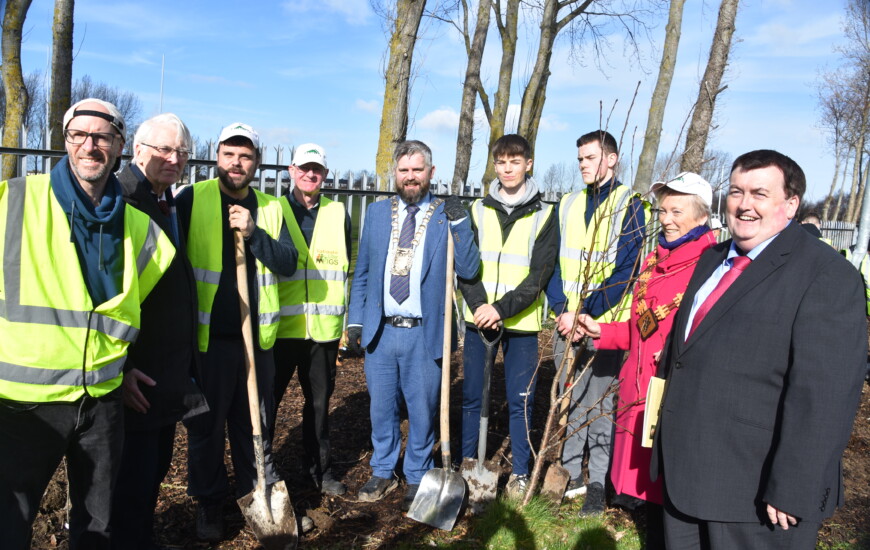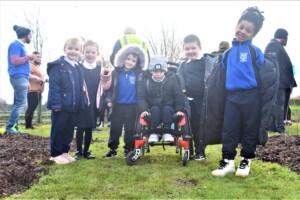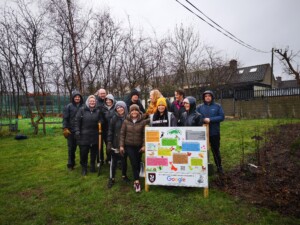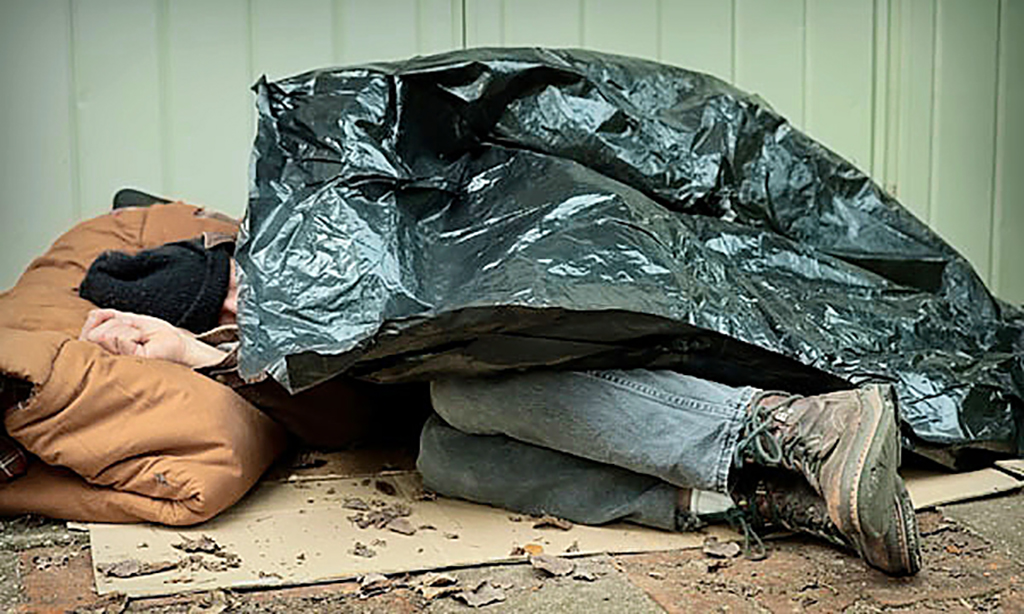Stepping Stone Forests can be a game changer
Padraig Conlon 21 Apr 2022
SOUTHSIDE People Editor Padraig Conlon sat down with John Kiberd to discuss Stepping Stone Forests, an exciting new initiative taking place in local schools.
Padraig Conlon: Can you tell the readers what a Stepping Stone Forest is John?
John Kiberd: Stepping Stone Forests are small woodlands of native Irish trees and shrubs. Typically they are 100 to 200 square meters in size and are usually planted on existing areas of lawn. The ground is prepared in such a way as to exclude any competition from grass and weeds and the trees are planted quite close to each other. This combination produces rapid growth.
PC: What makes them different to other forests?
JK: For a start they are planted in urban environments such as public green spaces, parkland, and in school grounds. The other difference is that Stepping Stone Forests are planted in two stages. We first prepare the planting area by putting down layers of newspapers and cardboard, and then covering that in a thick layer of wood chip mulch. After a number of months we then return to plant the trees and we plant them very densely, three trees per square meter.

Pictured at the launch of Stepping Stone Forests are Mayor of South County Dublin Peter Kavanagh and John Kiberd
PC: How did you come up with this particular planting method.
JK: It was inspired by a famous Japanese botanist called Akira Miyawaki. His methods are being applied right across the world including in India by Afforest, in the Netherlands by Tiny Forests, in France by Boomforest, in the UK by Earthwatch, and to an extent by LEAF Ireland in schools in Limerick. In fact Rachel Geary of LEAF was really helpful and supportive in the early days of the Stepping Stone Forest project planning.
PC: When and where did you plant your first Stepping Stone Forest?
JK: Although not technically called Stepping Stone Forests we planted three woodlands using our methods in Sean Walsh Park in Tallaght in December 2021. This was a collaboration with South Dublin County Council. The Council provided the site, the mulch, and 900 native trees and shrubs. We put a shout out to the local community for volunteers to provide the labour. Due to Covid-19 restrictions we actually had to limit the number of volunteers doing the planting. It was a wonderful example of the Council and the community coming together in an effort to improve our environment.
PC: It’s spring, how are those forests doing?
JK: Really well. Pretty much all of the spindly twigs that we planted before Christmas are bursting with new leaves.

Seven schools across Tallaght and Clondalkin now have their very own horseshoe-shaped forests that will grow very rapidly to create a perfect outdoor natural classroom
PC: You’ve just finished your Stepping Stone Forests for Schools program for 2021/22. How did that go.
JK: Brilliantly. Seven schools across Tallaght and Clondalkin now have their very own horseshoe-shaped forests that will grow very rapidly to create a perfect outdoor natural classroom. With the children we planted over 3,600 trees in total and that included 22 different species of native Irish trees.
PC: That’s a lot of trees. How involved are the children in the process?
JK: We try to involve the children as much as possible in the soil preparation and in the planting. These are their Stepping Stone Forests. The idea is that they are fully invested in the process and that they feel real ownership of their school woodlands. The children will grow and develop in parallel with the young forests.
PC: I see from some of your social media posts that Irish wildlife expert Éanna Ní Lamhna presented books to some of the schools. Is that a part of the Stepping Stone Forest project?
JK: Indeed it is. The book is ‘Wild Things at School’ and Éanna first published it back in 2009. It was out of print but with Éanna’s support and financial support from AWS In Communities and Google we were able to put it back into print. ‘Wild Things at Schools’ is a fantastic teaching tool that helps primary school children to learn about 48 key species of mammals, birds, amphibians, invertebrates and plants. It is free to all teachers in schools that are a part of the Stepping Stone Forests project.

Stepping Stone Forests are small woodlands of native Irish trees and shrubs
PC: You also place large colourful signs at the school forests.
JK: Yes. The signs are a type of infographic with information about the forest including what kinds of trees, animals, birds etc. might be found in the forest.
Each sign also shows the school crest, the forest sponsor name and logo, and a QR code that links to a web page that tells the story of the forest.
They are deliberately meant to be eye-catching. I want school visitors to be attracted to them and thereby learn about the forest. Hopefully some might be inspired to create their own Stepping Stone Forest.
PC: I noticed that the Dodder Action logo is also displayed. What role do they play?
JK: The role of Dodder Action and their volunteers has been a hugely significant part of the success of the Stepping Stone Forest project to date. Dodder Action is an important environmental organisation and their volunteers are fully committed to helping and supporting the environment in a whole raft of ways. The Stepping Stone Forests project is just one string to the Dodder Action bow.
PC: What next John?
JK: We are going into the planning phase for the 2022/23 season. While nothing has been decided yet I am hopeful that we will plant more than double the number of trees that we planted in the first phase.
PC: You say that you are hopeful, what are the possible factors that might limit your ambitions?
JK: There are only two really, finance and people. We have enough financial sponsorship in place for ten forests but we need more sponsors. We have a good pool of volunteers but we also need to deepen the pool. The South Dublin Volunteer Centre and An Taisce’s Climate Ambassador program have both been brilliant at providing volunteers to date but we need to widen the net further.
PC: Who has financed the forests that were planted and how much does a school forest cost?
JK: Based upon what we have learned to date we are budgeting for a cost of just under €2,500 per forest. Our sponsors last year were Tadg Riordan Motors, Maldron Tallaght, Henkel, Tallaght & District Credit Union, Google and AWS In Communities. I’m very grateful to all of these sponsors because they took a real leap of faith. They committed to the project when Stepping Stone Forests was just an idea, an unproven concept.
PC: You said that you have enough funds in place for 10 forests but that you want to do more. That means that you will need more sponsors. Is it only companies that can get involved?
JK: Absolutely not. While corporates will probably be the main source of funding I think that it would be nice if some past-pupils that have done well for themselves would want to leave a legacy to their old school. These forests will be around for along time so it would be a a wonderful living legacy to leave behind.
PC: So if companies or individuals want to get involved what do the need to do?
JK: All they have to do is to email us at info@steppingstoneforests.org
PC: Are you confining your activities to Tallaght and Clondalkin only, and if schools want to sign up for their very own school forest do they use the same email address?
JK: Yes, use info@steppingstoneforests.org and we are open to schools from anywhere in the Dublin area.
PC: In the long term will you extend beyond Dublin? In fact what are your ultimate ambitions for the Stepping Stone Forests project?
JK: We would like to see a Stepping Stone Forest in every school across Ireland that has the space for one. Obviously there is a limit to what our volunteers can do physically. However what we do is not rocket science.
We are going to document the various steps that there are to creating a school forest. Schools will then be free to create their own forest using the Stepping Stone Forest template. It will be a type of environmental and community franchise that will significantly boost the stock of native Irish trees across











